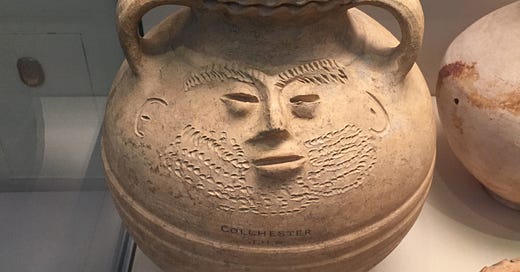August’s Thing of the Month is a Romano-British face pot, found in Colchester, and thought to date from circa 2 CE. Spotted in the British Museum, London.
The earliest examples of face pots—and the related head pot and neck flagons—date from around 2 BCE and have been found in Italy, Germany, France, Belgium and Britain. They’re thought to have arrived in Britain with the Roman invasion by Claudius in 43 CE, and subsequently taken up, adapted and hybridized by tribes from the south and east, up into the northern military zone. Specific designs found on Romano-British face pots vary remarkably, but they all follow a roughly similar scheme. Each features a simple sculpted face—eyes, nose, mouth, ears—positioned on or just below the neck of the vessel. This one in the British Museum also has eyebrows and a beard, along with two handles either side of the face. Other examples found have featured tongues and even small horns.
The purpose of the face pots is not entirely clear, and relatively little research has been done into them. Until recently, the leading expert was archaeologist and diplomat Jill Braithwaite. Richard Reece, writing in his 2008 obituary of her, recounted that Braithwaite’s interest in face pots began during a lecture in which she had fallen asleep. She “woke up from a short nap to be confronted by an enormous grotesque face leering at her.” It was a slide of a face pot. Reece—her lecturer—could not provide any information on its use or origin. She decided this needed to be rectified. Braithwaite concluded that the face pots were used as funerary urns and burial furniture. A more recent theory, argued by the academic Danielle Vander Horst, suggests that the face pots may have even functioned as proxies for real people in ritual settings. She also observed that the design of many of these vessels is impractical. The handles are often too small for the size of pot, and they don’t have pouring spouts, but their use as cooking and storage containers is still up for debate. It’s possible that they had a number of simultaneous uses, both practical and religious.
I’ve had an interest in Roman Britain since childhood. Ten minutes walk away from the house I grew up in is a farm. It’s situated on land that had once supported a Roman villa and an Anglo-Saxon settlement and cemetery. Each summer, when I was a child, the wheat would be harvested, the crop stubble burned, and the field would be ploughed. My dad was the village local historian, and at the end of the summer the farmer would let us go and walk his ridge-and-furrow fields. If you knew what to look for—flashes of red and orange in the brown earth—these walks would regularly turn up fragments of Roman roof tile. Occasionally we’d find bone shards. My dad would sometimes bring his high school pupils in a minibus to the farm and use it as a teaching aid. On one trip, a girl found a bronze Saxon brooch laying on top of the soil, its edges torn and mangled by the plough.
Among the most exciting finds—apart from human bones—were were two tile shards. We came across one bearing the deep imprint of a cat’s claw, as if the animal had slipped in the wet clay while running over it. Another had a shallow but distinct thumb print. To be able to pull a piece of ceramic out of the ground and put my thumb where someone had put theirs two millennia ago, to imagine a pesky cat running across some roofer’s handiwork, was a profound experience. What, I wanted to know, did a Romano-British cat want in the second century CE? Probably the same as cats want today. What did the roofer look like? What did they eat for breakfast? Did they enjoy their trade? Did they wish they were doing something else? Did they look across the hill to the next settlement and feel professional envy at the kind of roofing gigs someone else was getting?
The British Museum pot represents this feeling almost literally: a face from two-thousand years ago, grinning at you across time.
RECOMMENDATIONS
God bless whoever it is who has posted the near entirety of the late 1980s music show Snub TV on YouTube. Pixies, Butthole Surfers, Cookie Crew, House of Love, Dinosaur Jr., Ride, Spacemen 3, Turntable Orchestra, The KLF, Mekons, Wedding Present, 808 State, Happy Mondays, The Fall, Tackhead, We Are Going to Eat You, Teenage Fanclub, The Cramps, Spirea X… The Student Union bar is this way.
I first came across Mary Gaitskill’s writing in the expanded edition of Carl Wilson’s How To Talk about Love, a book about taste, judgement and Céline Dion. She wrote that “the easiest thing to forget” as a critic is that there’s a real person on the sharp end of your cultural snobberies. Then I turned to her 1988 debut, Bad Behavior, a collection of bleak but often funny stories about love, sex and loneliness in the big city. I just learned this week that she can also be found here on Substack.
New Pleasures is the latest album by Arp (aka the talented Alexis Georgopoulos). It’s the icy sequel to his bucolic 2018 album ZEBRA but hard to place, exactly, where and when this album happens. Paris in 1980? Los Angeles, yesterday? Somewhere on that crossfade. Today it sounds to me like a svelte 38 minutes of nu-rubber soul, chromed-electro, cosmic-erotic-techjazz, or whatever triple-switch-neologistic-plastic best fits the season’s shoe size. Bend it here.
Jean Achache’s documentary Before Midnight goes behind the scenes of Bertrand Tavernier’s 1986 film ’Round Midnight, the French director’s homage to his jazz heroes. Whether you’ve seen this movie or not, whether you even like it or not, it’s worth watching this simply to see the genius Herbie Hancock—who was the musical arranger and composer for the film—at work. If you’ve got access to the Criterion Collection, here’s your table.



